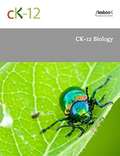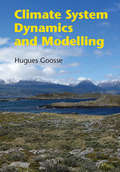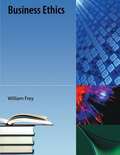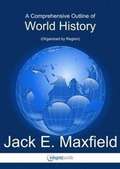- Table View
- List View
Introduction to Economic Analysis
by R. Preston McafeeThis book presents introductory economics ("principles") material using standard mathematical tools, including calculus. It is designed for a relatively sophisticated undergraduate who has not taken a basic university course in economics. It also contains the standard intermediate microeconomics material and some material that ought to be standard but is not. The book can easily serve as an intermediate microeconomics text. The focus of this book is on the conceptual tools and not on fluff. Most microeconomics texts are mostly fluff and the fluff market is exceedingly over-served by $100+ texts. In contrast, this book reflects the approach actually adopted by the majority of economists for understanding economic activity. There are lots of models and equations and no pictures of economists.
CK-12 Biology I (with image descriptions)
by Ck-12 FoundationOpen source biology textbook from CK-12.
Earth Systems, an Earth Science Course
by CurrikiThe Open Source Earth Science course has been organized to meet the CA Science Standards for Earth Sciences in grades 9 - 10, as adopted by the California State Board of Education. This course is part of a set of collections that contain additional Earth Science resources on Curriki that can be accessed at www.curriki.org.
Concept Development Studies in Chemistry
by John S. HutchinsonConcept Development Studies in Chemistry is a textbook for an Introductory General Chemistry course. Each module develops a central concept in Chemistry from experimental observations and inductive reasoning. This approach complements an interactive or active learning teaching approach.
Concept Development Studies in Chemistry
by John S Hutchinson"Concept Development Studies in Chemistry" is an on-line textbook for an Introductory General Chemistry course. Each module develops a central concept in Chemistry from experimental observations and inductive reasoning. This approach complements an interactive or active learning teaching approach.
CK-12 Probability and Statistics (Basic)
by Ck-12 FoundationAn open source textbook on probability and statistics.
Linear Algebra
by Paul DawkinsFrom the author: Here are my online notes for my Linear Algebra course that I teach here at Lamar University. Despite the fact that these are my "class notes", they should be accessible to anyone wanting to learn Linear Algebra or needing a refresher. These notes do assume that the reader has a good working knowledge of basic Algebra. This set of notes is fairly self contained but there is enough Algebra type problems (arithmetic and occasionally solving equations) that can show up that not having a good background in Algebra can cause the occasional problem.
A First Course In Linear Algebra
by Robert A. BeezerThis textbook is designed to teach the university mathematics student the basics of linear algebra and the techniques of formal mathematics. There are no prerequisites other than ordinary algebra, but it is probably best used by a student who has the "mathematical maturity" of a sophomore or junior. The text has two goals: to teach the fundamental concepts and techniques of matrix algebra and abstract vector spaces, and to teach the techniques associated with understanding the definitions and theorems forming a coherent area of mathematics. So there is an emphasis on worked examples of nontrivial size and on proving theorems carefully.
Introduction to Probability
by Charles M. Grinstead Laurie J. SnellAn open source textbook on probability.
CK-12 Single Variable Calculus
by Ck-12 FoundationIn this lesson we will review what you have learned in previous classes about mathematical equations of relationships and corresponding graphical representations and how these enable us to address a range of mathematical applications. We will review key properties of mathematical relationships that will allow us to solve a variety of problems. We will examine examples of how equations and graphs can be used to model real-life situations.
Vibrations and Waves
by Benjamin CrowellPart of the Light and Matter series of open source textbooks.
Introduction to Climate Dynamics and Climate Modeling
by Goosse H. W. Lefebvre V. Zunz P. Y. Barriat M. F. LoutreAn open source textbook. Bookshare demo title.
International Economics: Theory and Policy
by Steve SuranovicInternational Economics: Theory and Policy is built on Steve Suranovic’s belief that students need to learn the theory and models to understand how economics works and how economists understand the world. And, that these ideas are accessible to most students if they are explained thoroughly. So, if you are looking for an International Economics text that will prepare your PhD students while promoting serious comprehension for the non-economics major, Steve Suranovic’s International Economics: Theory and Policy is for you. International Economics: Theory and Policy presents numerous models in some detail; not by employing advanced mathematics, but rather by walking students through a detailed description of how a model’s assumptions influence its conclusions. Then, students learn how the models connect with the real world. Steve’s book covers positive economics to help answer the normative questions; for example, what should a country do about trade policy, or about exchange rate policy? The results from models give students insights that help us answer these questions. Thus, this text strives to explain why each model is interesting by connecting its results to some aspect of a current policy issue. This text eliminates some needlessly difficult material while adding and elaborating on other principles. For example, the development of the relative supply/demand structure, or the presentation of offer curves, are omitted as to not go too deeply into topics that tend to confuse many students at this level. Steve developed new approaches in this text including a simple way to present the Jones’ magnification effects, a systematic method to teach the theory of the second best, and a unique description of valid reasons to worry about trade deficits. These new approaches help students learn the concepts and models and derive conclusions from them. If you like to take a comprehensive look at trade policies, be sure to check out the chapter on Trade Policy (7). It provides a comprehensive look at many more trade policies than are found in many of the printed textbooks on the market today. International Economics: Theory and Policy by Steve Suranovic is intended for use in a full semester trade course, a full semester finance course, or a one semester trade/finance course.
Organizational Behavior - Version 1.1
by Talya BauerTwo leading researchers in Management, Talya Bauer and Berrin Erdogan, bring you a new Organizational Behavior textbook that bridges the gap between theory and practice with a distinct “experiential” approach. On average, a worker in the USA will change jobs 10 times in 20 years. In order to succeed in this type of career situation, individuals need to be armed with the tools necessary to be life-long learners. To that end, this book is not be about giving students all the answers to every situation they may encounter when they start their first job or as they continue up the career ladder. Instead, this book gives students the vocabulary, framework, and critical thinking skills necessary to diagnose situations, ask tough questions, evaluate the answers received, and to act in an effective and ethical manner regardless of situational characteristics. Often, students taking OB either do not understand how important knowledge of OB can be to their professional careers, or they DO understand and they want to put that knowledge into practice. Organizational Behavior by Bauer and Erdogan takes a more experiential angle to the material to meet both of those needs. The experiential approach can be incorporated in the classroom primarily through the “OB Toolbox.” This feature brings life to the concepts and allows students to not only see how the OB theories unfold, but to practice them, as well. One great example is the "OB Toolbox" here in the Leadership Chapter. Talya and Berrin's 1.1 version has an additional 14 cases for instructors to mix and match for their Organizational Behavior course. Some of the new cases included are: Nau, Goodwill Industries, Zappos.com, LinkedIn, Camden Property Trust, Steve Katzenberg, Edward Jones Investments, and Starbucks. A matrix to help instructors mix and match the cases is included in the updated Instructors Manual. In addition, discussion question have been added for each case, and the Toyota, Google, and Steve Jobs chapter opening cases have all been revised to reflect the most current information on the companies and people.
Motion Mountain: Light, Charges and Brains, Twenty-third edition)
by Christoph SchillerAnswering questions on motion, the book gives an entertaining and mind-twisting introduction into modern physics--one that is surprising and challenging on every page. Starting from everyday life, the adventure provides an overview of the recent results in mechanics, thermodynamics, electrodynamics, relativity, quantum theory, quantum gravity and unification. It is written for undergraduate students and for anybody interested in physics.
AP Environmental Science
by University of CaliforniaText associated with University of California College Prep (UCCP) Advanced Placement (AP) Environmental Science online course.
Applied Finite Mathematics
by Rupinder SekhonThis module contains all 10 chapters of the Applied Finite Mathematics open textbook by Rupinder Sekhon.
The Basic Elements of Music
by Catherine Schmidt-JonesExplanations (suitable for any age) of the basic elements of music, with suggested activities for introducing the each concept to children at early elementary school level. The course may be used by instructors not trained in music; all necessary definitions and explanations are included.
Business Ethics
by William FreyBusiness Ethics is a derived copy from the Corporate Governance course previously published in Connexions. While many courses using this title place emphasis on applying classical philosophical and ethical theory, this course's approach is decidedly interdisciplinary and practical. It is not designed as a socio-humanistic elective, a service philosophy course, or even an applied philosophical ethics course but as a laboratory, skills-based course where students develop, practice, and refine decision-making and problem-solving strategies that they will carry with them into the world of business practice. Emphasis has been placed on responding to the four ethical themes identified by the AACSB ethics task force: Ethical Leadership, Ethical Decision-Making, Social Responsibility, and Corporate Governance. Modules include (1) theory building activities (responsibility, rights, virtue), (2) problem specification frameworks emphasizing socio-technical system building and analogies with design, (3) specific modules responding to AACSB ethics themes (moral ecologies, corporate social responsibility, corporate governance, and a history of the modern corporation) and (4) modules that provide the course with a capstone, integrative experience (Business Ethics Bowl, Social Impact Statement Reports, and Corporate Ethics Compliance Officer Reports). While a quick glance shows that this collection holds more modules than can possibly be covered in a single semester, this approach gives the user flexibility as to the method used for integrating ethics into the business administration curriculum. Modules can be recombined into different standalone courses such as business ethics, business/government/society, or environment of organizations. Since each module can be covered independently, they can be integrated into the business administration curriculum as specific interventions in mainstream business courses in areas like accounting, finance, management, information systems, human resources or office administration. (In fact many have been written for and tested in these circumstances.) Business Ethics has been developed through the NSF-funded project, "Collaborative Development of Ethics Across the Curriculum Resources and Sharing of Best Practices," NSF SES 0551779.
A Comprehensive Outline of World History
by Jack MaxfieldThis course presents Jack E. Maxfield's "A Comprehensive Outline of World History" as originally organized, chronologically by era and across regions within an era.
Elementary Algebra
by Denny Burzynski Wade EllisElementary Algebra is a work text that covers the traditional topics studied in a modern elementary algebra course. It is intended for students who (1) have no exposure to elementary algebra, (2) have previously had an unpleasant experience with elementary algebra, or (3) need to review algebraic concepts and techniques.




